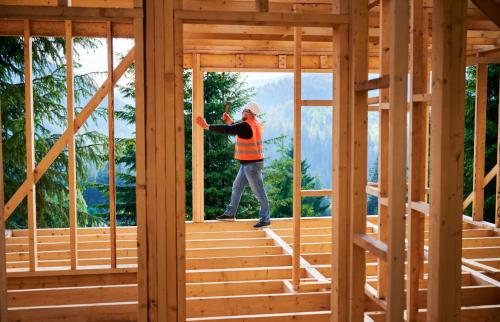Over the past decade, many cities around the world have experienced a significant rise in housing costs, and the large cities of New Zealand are no exception. The small nation’s median house price rose by approximately 130% between 2011 and 2021, far outpacing household income growth and eroding housing affordability.
Undersupply has contributed to these rising housing costs. Census data reveals that New Zealand’s population increased by 10.8% between 2013 and 2018, but the stock of occupied dwellings only increased by 6.6% over the same period—indicating that there are chronic shortages of housing in the locations where people want to live.
In response, the New Zealand government recently passed sweeping zoning reform legislation to permit medium-density housing in all of the country’s major cities. This policy builds on the earlier success of upzoning in the country’s largest city, Auckland, to redress housing shortages by encouraging higher-density housing. The reform is also part of a broader policy shift to encourage housing construction by allowing cities to build up.
New Zealand’s past zoning restrictions have led to increased housing costs and decreased homeownership rates
In October 2021, New Zealand’s center-left Labour government announced the zoning reform to stimulate housing construction through redevelopment. The so-called “Medium Density Residential Standard” will require the country’s most populous cities to permit up to three stories and three dwellings on all existing residential parcels of land. The policy would allow a parcel with a detached single-family dwelling to be redeveloped into row houses or a small apartment block.
 The reforms represent a significant reversal in the nation’s approach to urban planning and development. Since the 1980s, New Zealand has adopted land use policies that encouraged low-density housing in residential areas, entrenching detached single-family housing in its suburbs. Consequently, construction of high-rise apartment buildings has been limited to central business districts and areas zoned for commercial use. Construction of medium-density housing, such as the rowhouses that are commonly found in the cities on the East Coast of the United States, has been missing from the mix.
The reforms represent a significant reversal in the nation’s approach to urban planning and development. Since the 1980s, New Zealand has adopted land use policies that encouraged low-density housing in residential areas, entrenching detached single-family housing in its suburbs. Consequently, construction of high-rise apartment buildings has been limited to central business districts and areas zoned for commercial use. Construction of medium-density housing, such as the rowhouses that are commonly found in the cities on the East Coast of the United States, has been missing from the mix.
Although local governments are responsible for the design and implementation of zoning regulations, the prevalence of low-density housing was underpinned by national-level legislation governing land use. The 1991 Resource Management Act restricted urban development and has been repeatedly criticized for insufficient recognition of housing and infrastructure in its purpose and guiding principles. The act not only presented an impediment to building vertically, but it also hampered the ability of cities to grow horizontally. A long series of official inquiries has identified its shortcomings.
The Resource Management Act restrained housing supply and attendant infrastructure during a period of significant population growth. Between 1991 and 2018, New Zealand’s population grew by approximately two-thirds. Over the same period, the social impacts of increasing housing costs have become more acute. Housing costs for low-income New Zealanders have doubled as a proportion of their income since the 1980s, and homeownership rates have fallen while household debt has increased substantially.
Encouraging redevelopment is a bipartisan issue
Over the past decade, both center-left and center-right governments have deployed policies intended to rein in runaway house prices. These include both demand- and supply-side policies, such as a capital gains tax targeted at housing speculation, a ban on foreign investment in residential housing, fast-tracked inclusive housing developments, and state-subsidized housing development projects.
The effect of monetary and macro-prudential policy on house prices has also increasingly been put under the spotlight. Upon the onset of the COVID-19 pandemic, the country’s central bank dropped interest rates to all-time lows and removed macro-prudential restrictions on mortgage credit, fueling a further 20% to 40% increase in house prices in different regions across the country. The government reacted by pushing for the central bank to consider house prices when setting interest rates, raising concerns that the long-held independence of the central bank was being undermined.
Typically, a political party’s housing policies are criticized by the opposing party. However, the original announcement of the Medium Density Residential Standard in October was notable for being bipartisan. The minister for housing, Dr. Megan Woods, shared the podium with members of the opposition National Party when making the announcement, who made their own statements voicing their support. The bill was subsequently passed in December with bipartisan support.
Bipartisanship lends the zoning reform credibility. Policies to promote redevelopment and densification are often unpopular with local residents, which raises the possibility that the policy will be overturned after the next election. But the opposition party’s public support for the bill indicates that the law will remain in place even if it wins the next election in 2023. A bipartisan commitment removes political uncertainty and encourages developers and homebuyers to incorporate the policy changes into their decision making.
Construction in New Zealand’s largest city is booming
This is not the first time New Zealand has turned to zoning reforms to encourage housing construction. In 2016, the nation’s largest city, Auckland, upzoned approximately three-quarters of its residential land area under the Auckland Unitary Plan (AUP). Auckland houses about a third of the nation’s 5 million people, and is also the country’s commercial capital, accounting for 38% of the gross domestic product.
Although motivated by a variety of factors, the undersupply of housing and erosion of housing affordability were the prominent justifications for the zoning reforms introduced under the AUP. The municipal government for the entire metropolitan area, the Auckland Council, estimated that the plan tripled the dwelling capacity of the city.
My work with Peter Phillips shows that the AUP has enabled a construction boom. New housing units permitted have increased every year since the policy was enacted, with all of these increases occurring in the city’s upzoned areas.
 Immediately prior to the plan, new housing units permitted peaked at about 6,000 in 2015. By 2020, that figure had climbed to over 14,300.
Immediately prior to the plan, new housing units permitted peaked at about 6,000 in 2015. By 2020, that figure had climbed to over 14,300.
The policy also shifted residential construction into attached multifamily housing. Immediately prior to the plan, new dwelling permits for attached housing peaked at 1,300 in 2015; by 2020, that figure had climbed to 8,100. This means that most of the 14,300 new dwelling permits issued in 2020 were for attached housing. The policy also stimulated an increase in detached housing, but the increase is not nearly as great. Prior to the policy, detached permits peaked at about 4,700 in 2015; by 2019, that figure had risen to just under 6,200.
 Upzoning also encouraged a more compact city by stimulating construction in Auckland’s inner suburban areas, which span a radius of approximately 20 to 25 kilometers from the central business district. In 2015, about two in three housing permits issued were in the inner suburbs. By 2020, six out of every seven permits issued were for construction of a home in the inner suburbs.
Upzoning also encouraged a more compact city by stimulating construction in Auckland’s inner suburban areas, which span a radius of approximately 20 to 25 kilometers from the central business district. In 2015, about two in three housing permits issued were in the inner suburbs. By 2020, six out of every seven permits issued were for construction of a home in the inner suburbs.
The success of upzoning in Auckland provided the blueprint for more recent national zoning reforms, with the business case for the policy change based on construction activity and outcomes in the city’s medium-density zones.
Transit-oriented housing development further encourages more compact cities
The Medium Density Residential Standard comes on the heels of another national policy directive to encourage housing densification along public transit corridors. In 2020, the Labour government issued the National Policy Statement on Urban Development, which requires large cities to zone for residential structures of up to six stories within walking distance of rapid transit stations (approximately 800 meters, at the minimum recommendation).
In addition to redressing the housing shortages that have accumulated over the past three decades, transit-oriented housing development is intended to lower energy consumption through shorter commutes and increased patronage of public transit, assisting the country to meet its carbon neutrality goals.
New Zealand’s reforms have increased housing construction, but home prices are still high
New Zealand’s three zoning reform policies enacted over the past five years—the Auckland Unitary Plan, the National Policy Statement on Urban Development, and the Medium Density Residential Standard—add up to a shift to encourage more housing construction through a more compact form of urban development.
The results from Auckland to date indicate that these reforms can enable housing construction and redevelopment. This is important, as rezoning reforms do not always achieve their anticipated goals. Understanding and identifying the catalysts that enabled construction in Auckland can help policymakers in the design and implementation of zoning reforms in the future.
What remains to be seen is the extent to which zoning reforms can enhance affordability. If the increase in housing supply in Auckland and other cities can bring down house prices in the years to come, New Zealand’s reforms can be a model for other countries struggling with housing affordability to follow.
The Brookings Institution is committed to quality, independence, and impact.
We are supported by a diverse array of funders. In line with our values and policies, each Brookings publication represents the sole views of its author(s).







Commentary
New Zealand’s bipartisan housing reforms offer a model to other countries
January 24, 2022